Modifications and tips to cope with extremes of cold Weather.
This link was kindly supplied by Vlad of Norway where of course they get much colder weather than us in the UK, although Scotland and parts of the North have had it cold for the last couple of winters. 2010/2011
This link which has been translated from Russian using the Google translate and may be useful to other readers in Norway and other parts of the World where they have extremes of cold during the winter months.
It is understood that this is a Mercedes approved modification and parts are available
Link for details:-
Mercedes 'A' class Winter /Extend you heating system to incorporate your throttle body which will assist with starting and improve running during extremes of cold weather.
Mercedes 'A'-class Winter, Original Russian version,
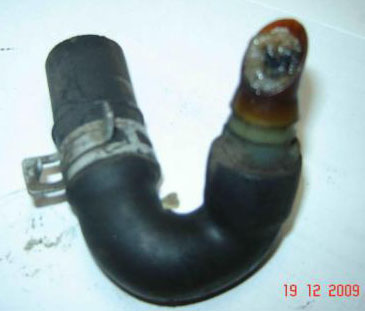
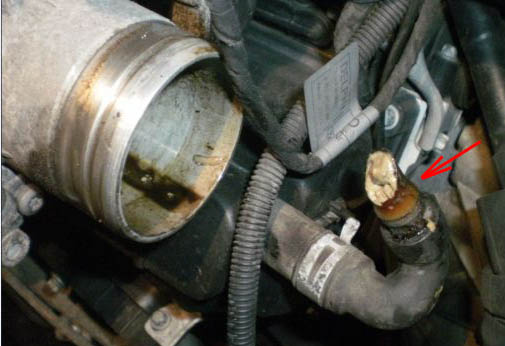 Clogged /frozen breather tube One of the points worth noting is that the accumulation of emulsion (Oil and water, yellow cream like mixture) that forms in the breather tube from the sump can also freeze solid, as is shown in the photo on the right.
Clogged /frozen breather tube One of the points worth noting is that the accumulation of emulsion (Oil and water, yellow cream like mixture) that forms in the breather tube from the sump can also freeze solid, as is shown in the photo on the right.
This can to some degree be overcome by cleaning the breather tube, however if this is not done the pressure in the sump will build up to such a degree that the dip stick will be forced partially out of its tube causing the pressurised oil be sprayed over the engine, This will be accompanied with the low oil warning sign displaying on the instrument cluster
Should you suffer at any time from this problem, STOP as soon as it is safe to do so, or you are likely to cause serious damage to the engine.
Do not attempt to remove the dip stick until the oil pressure has been fully relieved or you will loose even more oil and finish up coated it hot oil.
This is problem is caused because the sump pressure cannot be relieved in the normal way through the frozen and blocked sump breather tube which interconnects and normally vents back into the air intake.
Where oil has been discharged/spilled onto a road surface take precautions to ensure it is made safe for other road users, sand or grid will help, if thought necessary call the local authority to warn them of the problem.
if you are driving in extreme conditions you would be wise to ensure:-
(1) your breather tube is kept clear and (2) carry spare oil.
Other tips which will help your engine warm and run better during very cold spells
Partially cover the radiator with a suitable cover, although the fan does not run until the engine is really warm, on short runs the sooner the engine reached optimum running temperatures the better and the more fuel you will save.
However do keep an eye on the instrument cluster, if the max coolant temperature is reached a warning light will show.
this would not be recommended if you were doing long runs, unless driving in sub zero temperatures for long periods.
Air Intake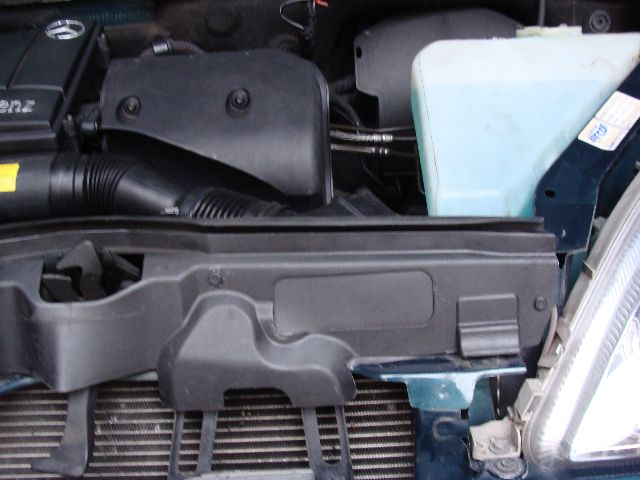
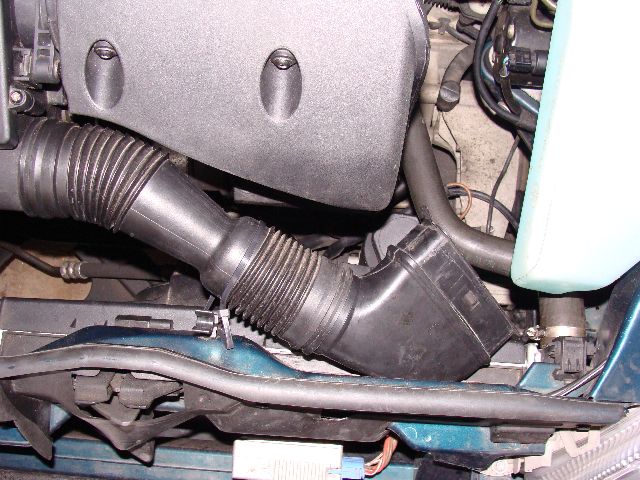
Another tip used by Vlad in Norway is to remove the air intake hose from the front cross member of the car and direct it to draw air from the engine bay, this prevents extremely cold, damp air, from entering the fuel/air intake pipe and throttle body which can only produce better engine performance.
In this example shown on my own car I have also blanked off the hole into which the air intake hose normally fits. The nozzle end of the hose rotates so it is easily repositioned to lay flat against the radiator /condenser pack
The air intake hose is secured with a cable tie to prevent rattles.
It is interesting to note that on one of my earlier cars this was a built in feature where the external air vent could be closed off during the winter months which automatically opened the located under the bonnet .
Having driven the car since altering its position it is had no adverse effect on engine performance and so I will be leaving it repositioned until the weather warms up.
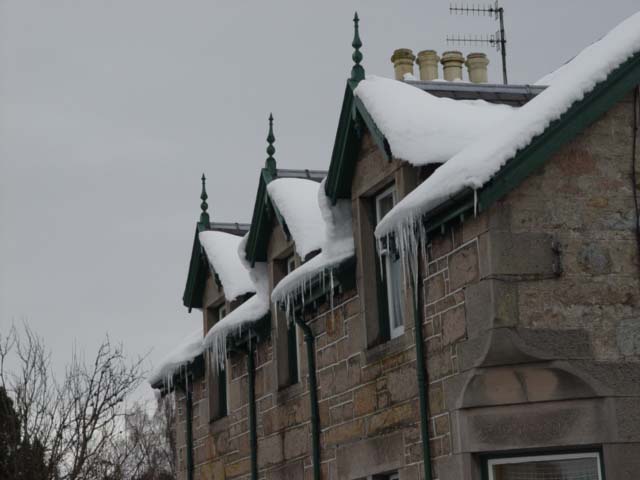
Anti-freeze, Anti-corrosion , Coolant.
Even if you do not live in Siberia it is important to ensure your engine is protected by the correct percentage of antifreeze before the cold weather arrives, remember also that Mercedes supplied Coolant fluid, contains anti-corrosive, antifreeze properties as well as coolant which allows the fluid in the cooling system to reach very high temperatures without boiling, this in turn ensures that you get maximum efficiency and well as MPG from your fuel. for details of the Cooling system and coolant fluid replacement see my page 43.
In addition to the coolant fluid you need also to ensure that the windscreen washer bottle is filled with fluid that will not freeze, Mercedes Fluid (part Number 03 60 03171) supplied in 500ml bottles when applied to 1 full washer reservoir on the A class will provide frost protection down to - 2.5 c (-27.5 F) this protection is vital if you are not to suffer the windscreen washer hoses either splitting or being pushed off the tube connectors, as well as screen washer pump damage. (Note there is only one pump which feed both front and rear washers on the 'A' Class )
One of the connectors most effected is the rear screen washer hose situated at the top of the 5th Door, I am aware of at least four instances of this happening during the cold winter 2010/11 for details of this problem and damage caused see my pages 42 & 24
Although that degree of protection will normally be adequate for cars in the UK, owners in climates which have more severe winters should look to increasing the percentage of windscreen washer concentrate to the washer container.
If the washer fluid can be maintained in a fluid state then the heated nozzles fitted on the front of the vehicle will ensure that screen wash fluid reaches the windscreen, although it is preferable not to use them unless absolutely necessary as the fluid will freeze on the screen until the cars heater is sufficiently warmed up to enable the screen to be defrosted.
Tyres
Owners in climates affected by severe winters invariably run on winter tyres however this is not normally the case in the UK, if caught out by severe weather, snow, dropping the tyre pressures just a few pounds can assist with traction. Remembering to return them to the correct running pressure as soon as conditions allow.
Winter tyres your questions answered
ABS/ASR(Active Braking System/Anti-Slip Regulation.(Traction Control)
ABS fitted to the 'A' Class can be a useful tool if you suddenly have to brake hard to avoid a collision.
In the same way ASR (Anti slip regulation)is useful but during slippery icy conditions it can hinder the driver when trying to pull away, if this occurs the ASR can be switched off using the switch marked ASR on the dash board which will allow the driver to pull away using traction from both wheels without the ABS kicking in.( The active braking system will operate in any situation where a wheel starts to spin or looses traction. This will show itself by a gunning like sound which will be heard as the system brakes the spinning wheel)
When the ASR is switched off or one or both of the drive wheels loose traction a amber triangle light with an asterisk (!) will appear top centre of the instrument cluster.
Always switch the ASR back to the ON position as soon as you are moving.
If traction is lost when the ASR is ON the light will intermittently flash on the instrument cluster, when cornering at speed it a typical example when the light will be seen to flash on then off, caused by a wheel or wheels loosing traction with the road surface.
Batteries
Due to the excessive demand on batteries during the cold winters, Batteries should be serviced by topping up the fluid as necessary and fully charging,
The demand on the battery when sitting in traffic jams with the engine only ticking over is high, you can reduce the load by switching off none essential items, although the need to stay warm and in touch with the outside world by phone or listening to your radio is essential.
If conditions are so bad that your car cannot be driven then there is some wisdom in removing the battery from the vehicle, it is a wise move to take the opportunity trickle charge it while off the car.
Plastic and rubber components Remember Plastic components become very brittle when cold, the front wings for instance being plastic will tolerate the odd knock during the warmer months where as in the winter they will crack and break and that's in a climate which does not fall many degrees below 32 Fahrenheit.
In extreme conditions even rubber pipes can become brittle and can shatter, avoid where possible working on these items during extreme cold weather.
Vlad has also pointed out the even the outer casing on electrical wiring can be snapped during excessively cold conditions so try to avoid working on your car, full stop, unless the vehicle can be housed in a warmer environment.
 I like to thank Vlad pictured on the right for his comments which I have included in this page.
I like to thank Vlad pictured on the right for his comments which I have included in this page.
Next.
Back to Index,
Purchase DVD.
Please Make a Donation.
This link which has been translated from Russian using the Google translate and may be useful to other readers in Norway and other parts of the World where they have extremes of cold during the winter months.
It is understood that this is a Mercedes approved modification and parts are available
Link for details:-
Mercedes 'A' class Winter /Extend you heating system to incorporate your throttle body which will assist with starting and improve running during extremes of cold weather.
Mercedes 'A'-class Winter, Original Russian version,
 Clogged /frozen breather tube One of the points worth noting is that the accumulation of emulsion (Oil and water, yellow cream like mixture) that forms in the breather tube from the sump can also freeze solid, as is shown in the photo on the right.
Clogged /frozen breather tube One of the points worth noting is that the accumulation of emulsion (Oil and water, yellow cream like mixture) that forms in the breather tube from the sump can also freeze solid, as is shown in the photo on the right.This can to some degree be overcome by cleaning the breather tube, however if this is not done the pressure in the sump will build up to such a degree that the dip stick will be forced partially out of its tube causing the pressurised oil be sprayed over the engine, This will be accompanied with the low oil warning sign displaying on the instrument cluster
Should you suffer at any time from this problem, STOP as soon as it is safe to do so, or you are likely to cause serious damage to the engine.
Do not attempt to remove the dip stick until the oil pressure has been fully relieved or you will loose even more oil and finish up coated it hot oil.
This is problem is caused because the sump pressure cannot be relieved in the normal way through the frozen and blocked sump breather tube which interconnects and normally vents back into the air intake.
Where oil has been discharged/spilled onto a road surface take precautions to ensure it is made safe for other road users, sand or grid will help, if thought necessary call the local authority to warn them of the problem.
if you are driving in extreme conditions you would be wise to ensure:-
(1) your breather tube is kept clear and (2) carry spare oil.
Other tips which will help your engine warm and run better during very cold spells
Partially cover the radiator with a suitable cover, although the fan does not run until the engine is really warm, on short runs the sooner the engine reached optimum running temperatures the better and the more fuel you will save.
However do keep an eye on the instrument cluster, if the max coolant temperature is reached a warning light will show.
this would not be recommended if you were doing long runs, unless driving in sub zero temperatures for long periods.
Air Intake


Another tip used by Vlad in Norway is to remove the air intake hose from the front cross member of the car and direct it to draw air from the engine bay, this prevents extremely cold, damp air, from entering the fuel/air intake pipe and throttle body which can only produce better engine performance.
In this example shown on my own car I have also blanked off the hole into which the air intake hose normally fits. The nozzle end of the hose rotates so it is easily repositioned to lay flat against the radiator /condenser pack
The air intake hose is secured with a cable tie to prevent rattles.
It is interesting to note that on one of my earlier cars this was a built in feature where the external air vent could be closed off during the winter months which automatically opened the located under the bonnet .
Having driven the car since altering its position it is had no adverse effect on engine performance and so I will be leaving it repositioned until the weather warms up.
Anti-freeze, Anti-corrosion , Coolant.
Even if you do not live in Siberia it is important to ensure your engine is protected by the correct percentage of antifreeze before the cold weather arrives, remember also that Mercedes supplied Coolant fluid, contains anti-corrosive, antifreeze properties as well as coolant which allows the fluid in the cooling system to reach very high temperatures without boiling, this in turn ensures that you get maximum efficiency and well as MPG from your fuel. for details of the Cooling system and coolant fluid replacement see my page 43.
In addition to the coolant fluid you need also to ensure that the windscreen washer bottle is filled with fluid that will not freeze, Mercedes Fluid (part Number 03 60 03171) supplied in 500ml bottles when applied to 1 full washer reservoir on the A class will provide frost protection down to - 2.5 c (-27.5 F) this protection is vital if you are not to suffer the windscreen washer hoses either splitting or being pushed off the tube connectors, as well as screen washer pump damage. (Note there is only one pump which feed both front and rear washers on the 'A' Class )
One of the connectors most effected is the rear screen washer hose situated at the top of the 5th Door, I am aware of at least four instances of this happening during the cold winter 2010/11 for details of this problem and damage caused see my pages 42 & 24
Although that degree of protection will normally be adequate for cars in the UK, owners in climates which have more severe winters should look to increasing the percentage of windscreen washer concentrate to the washer container.
If the washer fluid can be maintained in a fluid state then the heated nozzles fitted on the front of the vehicle will ensure that screen wash fluid reaches the windscreen, although it is preferable not to use them unless absolutely necessary as the fluid will freeze on the screen until the cars heater is sufficiently warmed up to enable the screen to be defrosted.
Tyres
Owners in climates affected by severe winters invariably run on winter tyres however this is not normally the case in the UK, if caught out by severe weather, snow, dropping the tyre pressures just a few pounds can assist with traction. Remembering to return them to the correct running pressure as soon as conditions allow.
Winter tyres your questions answered
ABS/ASR(Active Braking System/Anti-Slip Regulation.(Traction Control)
ABS fitted to the 'A' Class can be a useful tool if you suddenly have to brake hard to avoid a collision.
In the same way ASR (Anti slip regulation)is useful but during slippery icy conditions it can hinder the driver when trying to pull away, if this occurs the ASR can be switched off using the switch marked ASR on the dash board which will allow the driver to pull away using traction from both wheels without the ABS kicking in.( The active braking system will operate in any situation where a wheel starts to spin or looses traction. This will show itself by a gunning like sound which will be heard as the system brakes the spinning wheel)
When the ASR is switched off or one or both of the drive wheels loose traction a amber triangle light with an asterisk (!) will appear top centre of the instrument cluster.
Always switch the ASR back to the ON position as soon as you are moving.
If traction is lost when the ASR is ON the light will intermittently flash on the instrument cluster, when cornering at speed it a typical example when the light will be seen to flash on then off, caused by a wheel or wheels loosing traction with the road surface.
Batteries
Due to the excessive demand on batteries during the cold winters, Batteries should be serviced by topping up the fluid as necessary and fully charging,
The demand on the battery when sitting in traffic jams with the engine only ticking over is high, you can reduce the load by switching off none essential items, although the need to stay warm and in touch with the outside world by phone or listening to your radio is essential.
If conditions are so bad that your car cannot be driven then there is some wisdom in removing the battery from the vehicle, it is a wise move to take the opportunity trickle charge it while off the car.
Plastic and rubber components Remember Plastic components become very brittle when cold, the front wings for instance being plastic will tolerate the odd knock during the warmer months where as in the winter they will crack and break and that's in a climate which does not fall many degrees below 32 Fahrenheit.
In extreme conditions even rubber pipes can become brittle and can shatter, avoid where possible working on these items during extreme cold weather.
Vlad has also pointed out the even the outer casing on electrical wiring can be snapped during excessively cold conditions so try to avoid working on your car, full stop, unless the vehicle can be housed in a warmer environment.
 I like to thank Vlad pictured on the right for his comments which I have included in this page.
I like to thank Vlad pictured on the right for his comments which I have included in this page. Next.
Back to Index,
Purchase DVD.
Please Make a Donation.